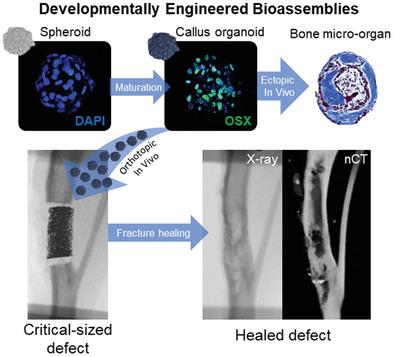Our official English website, www.x-mol.net, welcomes your
feedback! (Note: you will need to create a separate account there.)
Developmentally Engineered Callus Organoid Bioassemblies Exhibit Predictive In Vivo Long Bone Healing.
Advanced Science ( IF 14.3 ) Pub Date : 2019-12-10 , DOI: 10.1002/advs.201902295 Gabriella Nilsson Hall 1 , Luís Freitas Mendes 1 , Charikleia Gklava 1 , Liesbet Geris 2, 3, 4 , Frank P Luyten 1 , Ioannis Papantoniou 1, 5
Advanced Science ( IF 14.3 ) Pub Date : 2019-12-10 , DOI: 10.1002/advs.201902295 Gabriella Nilsson Hall 1 , Luís Freitas Mendes 1 , Charikleia Gklava 1 , Liesbet Geris 2, 3, 4 , Frank P Luyten 1 , Ioannis Papantoniou 1, 5
Affiliation

|
Clinical translation of cell-based products is hampered by their limited predictive in vivo performance. To overcome this hurdle, engineering strategies advocate to fabricate tissue products through processes that mimic development and regeneration, a strategy applicable for the healing of large bone defects, an unmet medical need. Natural fracture healing occurs through the formation of a cartilage intermediate, termed "soft callus," which is transformed into bone following a process that recapitulates developmental events. The main contributors to the soft callus are cells derived from the periosteum, containing potent skeletal stem cells. Herein, cells derived from human periosteum are used for the scalable production of microspheroids that are differentiated into callus organoids. The organoids attain autonomy and exhibit the capacity to form ectopic bone microorgans in vivo. This potency is linked to specific gene signatures mimicking those found in developing and healing long bones. Furthermore, callus organoids spontaneously bioassemble in vitro into large engineered tissues able to heal murine critical-sized long bone defects. The regenerated bone exhibits similar morphological properties to those of native tibia. These callus organoids can be viewed as a living "bio-ink" allowing bottom-up manufacturing of multimodular tissues with complex geometric features and inbuilt quality attributes.
中文翻译:

发育工程愈伤组织类生物组装体表现出体内长骨愈合的预测能力。
基于细胞的产品的临床转化因其有限的体内预测性能而受到阻碍。为了克服这一障碍,工程策略主张通过模拟发育和再生的过程来制造组织产品,这是一种适用于治疗大骨缺损(未满足的医疗需求)的策略。骨折自然愈合是通过软骨中间体(称为“软愈伤组织”)的形成而发生的,该软骨中间体在经历发育事件的过程后转化为骨骼。软愈伤组织的主要贡献者是来自骨膜的细胞,其中含有有效的骨骼干细胞。在此,源自人类骨膜的细胞用于大规模生产分化为愈伤组织的微球体。类器官获得自主性并表现出在体内形成异位骨微器官的能力。这种效力与模仿长骨发育和愈合过程中发现的特定基因特征有关。此外,愈伤组织类器官在体外自发地生物组装成大型工程组织,能够治愈小鼠临界尺寸的长骨缺损。再生骨表现出与天然胫骨相似的形态特性。这些愈伤组织类器官可以被视为一种活的“生物墨水”,允许自下而上地制造具有复杂几何特征和内在质量属性的多模块组织。
更新日期:2019-12-11
中文翻译:

发育工程愈伤组织类生物组装体表现出体内长骨愈合的预测能力。
基于细胞的产品的临床转化因其有限的体内预测性能而受到阻碍。为了克服这一障碍,工程策略主张通过模拟发育和再生的过程来制造组织产品,这是一种适用于治疗大骨缺损(未满足的医疗需求)的策略。骨折自然愈合是通过软骨中间体(称为“软愈伤组织”)的形成而发生的,该软骨中间体在经历发育事件的过程后转化为骨骼。软愈伤组织的主要贡献者是来自骨膜的细胞,其中含有有效的骨骼干细胞。在此,源自人类骨膜的细胞用于大规模生产分化为愈伤组织的微球体。类器官获得自主性并表现出在体内形成异位骨微器官的能力。这种效力与模仿长骨发育和愈合过程中发现的特定基因特征有关。此外,愈伤组织类器官在体外自发地生物组装成大型工程组织,能够治愈小鼠临界尺寸的长骨缺损。再生骨表现出与天然胫骨相似的形态特性。这些愈伤组织类器官可以被视为一种活的“生物墨水”,允许自下而上地制造具有复杂几何特征和内在质量属性的多模块组织。











































 京公网安备 11010802027423号
京公网安备 11010802027423号